Methods of connecting electrical wires: types of connections + technical nuances
When installing an additional outlet, connecting a new chandelier, or troubleshooting a fault in the electrical wiring, you will have to deal with electrical work. Without practical experience, it is difficult to ensure reliable contact between conductors made of different materials, having different cross-sections or even different numbers of cores.
The article we have proposed describes in detail all the methods of connecting electrical wires that are used in the construction of electrical wiring. We analyzed the technical and technological features of each option. With our advice, you can successfully repair or upgrade your electrical network.
The content of the article:
Preparing to connect wires
Any electrical installation work should be carried out competently. It is important to remember that the safety and life of all people and animals living in a house, apartment or country house depends on the correctness of their implementation. A mistake is unacceptable - at best there will be no good contact. And these are non-working electrical points.
In the worst case scenario, a visiting family member, friend or acquaintance could be electrocuted by an improperly insulated connection. Or the wiring will catch fire, which could lead to a fire.
For high-quality and correct execution of electrical wire connections, you need:
- knowledge of the basic types and principles of connections;
- availability of special tools for electrical installation work;
- availability of all consumables that will be useful when performing a specific type of connection;
- preliminary training on individual sections of wires.
When everything you need is available, you should carefully prepare your future place of work. To do this, you need to de-energize all the wires that you have to deal with. This is a very important step that cannot be ignored!

To avoid getting an electric shock, it is better to make sure once again that the apartment or house is actually de-energized. In this case, it is convenient to use an indicator screwdriver - this is an inexpensive tool that can even be purchased in an online store.
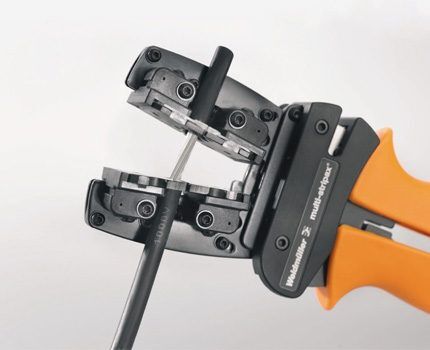
In a situation where there are serious concerns about the advisability of carrying out electrical installation work yourself, it is better to contact an electrician. Moreover, you should invite only an experienced craftsman who has not only experience in carrying out such work, but also special education.
Electrician services will be especially relevant if you have to Rewiring throughout the entire apartment/home. You can’t save on this - you can end up paying double or triple the price, or even pay with your property.
Overview of popular connection types
The main types of connections used in electrical wiring device for household needs, there are about 10 options.Among them, there are both simple ones that can be performed without many years of experience, and more complex methods that require not only experience, but also special tools and skills to work with them.
Complex connection options
The connection of two or more wires is carried out in order to obtain high-quality contact. It is he who will ensure the operability of all electrical points in a particular house or apartment.
You can establish reliable contact between conductors on your own or invite a specialist. It all depends on the type of connection chosen, the availability of tools and skills in carrying out such work.
Complex types of connections include:
- soldering;
- welding;
- crimping.
These options will be quite difficult for a beginner to cope with. The fact is that to solder an assembly of two or more conductors you will need a special tool, the skills to work with it are one awkward movement and instead of reliable contact you can get the opposite result.
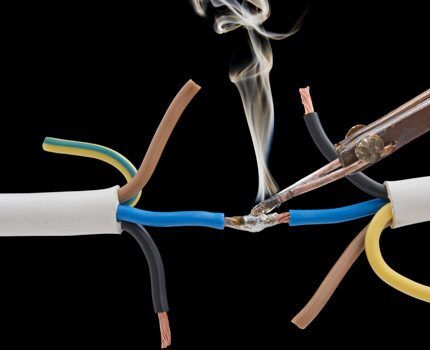
The essence of this method is to remove the insulation from the conductors of the connected conductors and sand them to a shine. Then you need to apply rosin to each vein with a brush and heat it thoroughly with a soldering iron - the stripped metal should be covered with an even layer of rosin on all sides.
When all the conductor strands are prepared, all that remains is to twist them well and heat the solder with a soldering iron, and also heat the resulting twist until the rosin boils. Now you need to apply solder with a soldering iron to the heated assembly of conductors and ensure that it flows evenly between the individual wires.
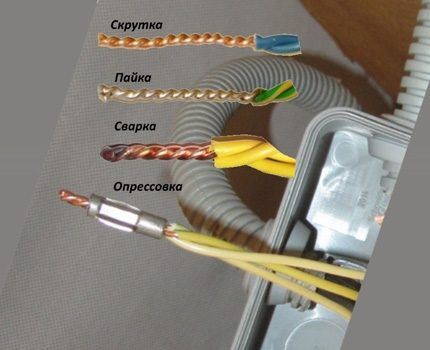
Once it has been possible to obtain a complete distribution of liquid solder over the entire surface to be soldered, soldering can be completed. Now all that remains is to wait until the resulting assembly cools down naturally.
Welding is an even more complex type of connection. To complete it you will need:
- welding machine;
- carbon electrode;
- flux, which will protect the melt from exposure to oxygen;
- protective mask for the face and special heat-resistant gloves for the hands.
And the most important thing when working with welding is the ability to use the device. In the hands of an amateur, instead of a reliable contact that can last 30-50 years, a melted conductor and damaged insulation will come out from under the welding machine.
Before starting welding, you need to twist, just like before soldering, having previously stripped the ends of the cores to shine. The essence of welding is to obtain a monolithic metal joint. To do this, you need to pour flux into the recess of the carbon electrode, turn on the welding machine and lower the end of the twist into the same recess.
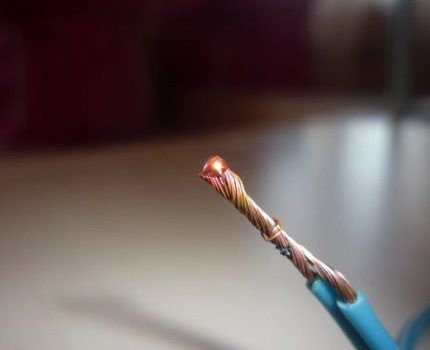
As a result of welding, the ends will melt and a metal ball will form on them. You need to wait for it to cool, clean it of flux and varnish it.
For crimping, you will also need special equipment - press pliers, also called a crimper, and a metal sleeve made of copper, aluminum, a combined alloy or insulation.
To obtain high-quality contact using this method, you need to prepare the conductor cores in the same way as before soldering. Better for cleaning use a stripper, as a last resort, side cutters. Then take the sleeve and place the prepared conductors of one conductor into it on one side, and the second conductor on the other.
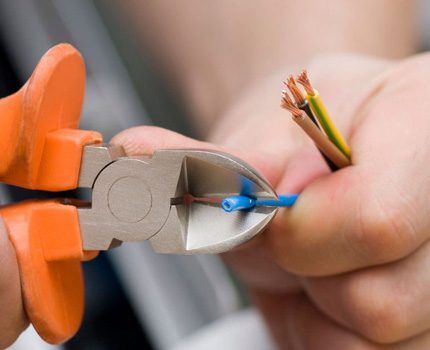
Now you have to use press pliers to compress the connection on both sides. It is important that the sleeve or other type wire clamp The diameter matches the cross-section of the wires being connected - the wires must fit freely inside.
After compression with a crimper, you should check the quality of the crimping - you need to tug one and the other wire. If they are tightly clamped and do not fall out of the sleeve, then the contact is successful.
All connections obtained as a result of soldering, welding or crimping must be insulated. To do this, use electrical tape or heat shrink tubing.
The second option is more convenient and is now used by both professional electricians and home craftsmen. Moreover, when creating a contact using crimping, the heat-shrinkable tube must be put on before inserting the cores into the sleeve.
Easy ways to create contacts
In addition to labor-intensive and complex options for creating a contact, which require skill and special tools, there are simpler ones that can be easily mastered with your own hands. Such methods are acceptable for connecting two or more wires with different cross-sections or the same. And the material of the cores can be different - copper, aluminum or steel.
Simple methods most often used at home include the following compounds:
- twist;
- bolted;
- screw;
- self-clamping.
There are two options for twisting, which can be done at home. The first is to simply twist the wires, stripped to a shine, and wrap electrical tape or heat-shrink tubing over it. The second option is to screw a PPE cap over the twist.

The first option is a relic of the past. Such connections are unreliable, they can fall apart and contact is lost. In the second case, reliability is opposed by the high price for one cap. It is not worth buying cheaper products - they cannot withstand the inclusion of a powerful heater in the network or other electrical appliances.
For a bolted connection, you need to prepare a bolt, washers one more than the number of conductors to be connected, and a nut. When creating a contact, the conductors are prepared in the same way as before welding or soldering. One condition is that the length of the stripped core should be enough to wrap around the bolt 3-4 times.
First, a washer is put on, then the conductor core is wound, then the washer again, again the core of the second conductor, the washer again, etc. When the cores of all conductors are wound, the last washer is put on and the whole thing is secured with a nut. The key must be used to tighten the connection well to ensure good contact. The resulting node must be isolated.
Another simple and inexpensive method is screw connections. They are made using terminal blocks. Moreover, the length of the area that needs to be cleaned from insulation to a shine depends on the model of the device and the cross-section of the conductor.
The simplest option is self-clamping devices or WAGO terminal blocks. They create a reliable contact and are easy to use. Another advantage is the possibility of reusable use. Even a person very far from electrical installation can remove and reinstall WAGO.
Which option should you prefer?
To choose the right execution method conductor connections, you should take into account the specifics of your situation, assess the volume of future work and your skills. If we are talking about replacing a chandelier, then there is no point in learning the intricacies of welding and buying a welding machine. Here you can spend money on buying original German WAGO terminal blocks.
When there is a full-scale renovation of an apartment or house with replacement of wiring, it is more advisable to use the welding method. If you don’t have the skills to work with this equipment, then you can practice doing high-quality crimping and create all the contacts yourself.
Junction boxes often use screw or self-clamping terminal blocks. But there is one caveat - they should be tightened periodically. Therefore, it is necessary to arrange the boxes in such a way as to ensure easy access to them for inspection.
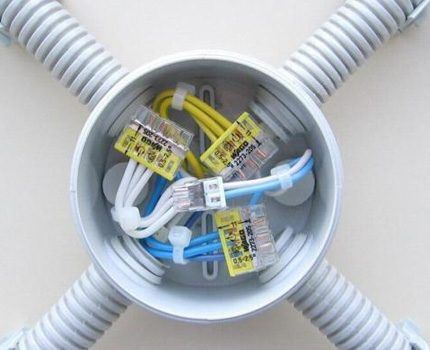
Using regular twisting and, as before, wrapping electrical tape on top is extremely dangerous. Moreover, this option is prohibited by electrical installation rules.
Technical nuances of the main types of connections
Each of the popular types of contact creation has its own characteristics. Thus, only single-core conductors of the same material can be connected by twisting.
If you need to create a contact with multi-core wires, then you need to use special tips - they compress the bundle of small wires. After installing the lug, the conductor can be connected to the terminal clamp without a clamping strip.
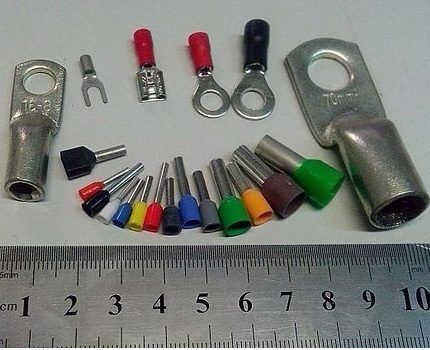
If you have to make up to ten connections, then it is advisable to choose German Vago terminal blocks. They allow you to connect conductor cores of different cross-sections and materials. For different materials, it is better to choose Wago with anti-corrosion paste.
But here you should be extremely careful not to buy a Chinese counterfeit.
The main differences between the original WAGO and the Chinese ones:
- The Chinese fake has a contact strip that is 2 times thinner than the original. It is dangerous to hang more than 5 Amps on a Chinese terminal block;
- the original mechanism is not magnetic, but the Chinese one is;
- There are no instructions for use on the back of the Chinese fake.
And the plastic of a real self-clamping terminal block is many times better quality. Therefore, it can easily withstand the load indicated on the reverse side.
You can also use soldering or welding to create contact between wires with different cross-sections. Such a connection will be strong and durable. Of course, if it was done professionally.
Another important nuance is to always isolate contacts.This is true for simple twisting, soldering, crimping and welding. And also to create contact using a bolt.
The bolted connection is a cheap, easy-to-use and durable option. And conductors of different cross-sections and materials are capable of creating reliable contact here. True, it takes up a lot of space when compared with the PPE cap or Vago terminal blocks.
Conclusions and useful video on the topic
To properly compress the sleeve when connecting electrical wires, you will need training and a special tool - press pliers. Detailed crimping process in the video:
Even the most expensive terminal block can turn out to be a cheap fake. The video clip demonstrates the main differences between the original Wago:
The video shows a method of bolting copper and aluminum wire:
The connection of wires using welding can be seen in the video clip:
When choosing a method for connecting electrical wires, you should focus on the feasibility of its use in a particular situation. If you need to completely replace the wiring in your house/apartment, but have no personal experience in electrical work, as well as special tools, the best option is to invite a professional electrician. This solution will allow you not to worry about the safety of your home.
Share your own experience in making electrical connections. It is possible that your advice will be useful to site visitors. Please write comments, post photos on the topic, ask questions in the block below for two-way communication.




The article is useful mainly for those who have just started working with electricians, but professionals also have a lot to learn)
I can’t call myself a pro, but I’ve been laying wires for several years at an amateur level, and various nuances often arise. For myself, I took several new types of wire connections (especially for different wires) and realized what mistakes I had made.
If you are changing the wiring in the house, then take the time to make a good connection of the wires. Any twists have a certain service life, after which problems will begin, which is why you will have to break the walls again. I always do this for myself: I connect the wires with a good twist, then I solder the twist with a powerful soldering iron and secure the connection with a PPE cap. It turns out forever. Yes, and NEVER directly connect wires of different metals. If such a need arises, purchase special terminal blocks for these purposes in the store.
I am a professional electrical installer.I tried different wire connections, but settled on welding. The main thing is to have a good welder suitable for this task with a current regulator and accessories. I cover the welded conductors with a special insulating cap.